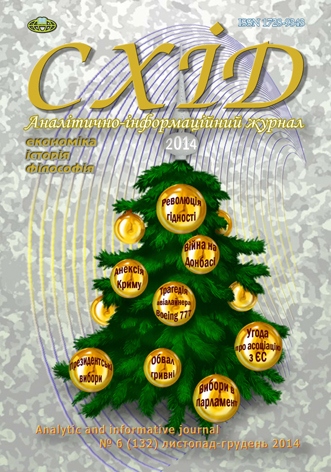Organizational and analytical frameworks for diagnostics human capital
DOI:
https://doi.org/10.21847/1728-9343.2014.6(132).36009Keywords:
human capital, diagnosis of human capital, phase of the reproduction of human capital, formation, use, accumulation, preservation of human capitalAbstract
The authors propose organizational and analytical support for the diagnosis of human capital, which aims to create a procedure, that is, the established order, the carrying out of diagnostics. The main goals of organizational and analytical support of the diagnosis of human capital should include the following: diagnosis; determination of prospects of development of human capital as a diagnosis; development of programs, strategies, and concepts for the development of human capital based on diagnostic results; implementation of development programs and their monitoring; monitoring the implementation of the proposed measures. It is proved that the prioritization of human capital development should occur on the basis of the diagnostic results depending on the diagnosis, i.e. in accordance with the existing problems of its reproduction. The perspectives of human development should be developed in accordance with the basic stages of development of human capital, i.e. acquisition, use, accumulation and preservation. The use of this approach allows to define clearly the prospects for the development of human capital, taking into account the particular features and conditions on each phase. Diagnosis is the diagnosis, which should include an assessment of the research object at the time of diagnosis. It is proved that the prioritization of human capital development should occur on the basis of the diagnostic results depending on the diagnosis, i.e. in accordance with the existing problems of its reproduction. Definition prospects for human development should be developed in accordance with the basic stages of development of human capital, i.e. acquisition, use, accumulation and preservation. The use of this approach allows to define clearly the prospects for the development of human capital, taking into account the particular features and conditions on each phase.
Managing the development of human capital is useful to consider how the process of planning, organization, motivation and control phases of acquisition, use, accumulation and preservation of human capital to increase its quantitative and qualitative characteristics. These processes need to be investigated at the macro and macro levels, which is caused by the peculiarities of reproduction of human capital at each level. Monitoring the implementation of programs, strategies human capital development is based on the establishment of regulatory indicators, measurable targets and reasonable tolerance by comparing the diagnostic indicators of human capital with the proposed standards.Downloads
References
Antoniuk V. P. (2007), The creation and use of human capital in Ukraine: the socio-economic assessment and provision of, National Academy of Sciences of Ukraine, Institute of Industrial Economics, Donetsk, 348 p. (ukr).
Bekker H. (1975), Human capital, available at: http://www.libertarium.ru/69974 (rus).
Hrishnova O. A. (2001), Human capital: the formation of a system of education and training, Kyiv, 254 p. (ukr).
Dobrynin A. Y., Diatlov S. A., Tsyrenova E. D. (1999), Human capital in transitive economy: the formation, evaluation, efficiency of use, Saint Petersburg, 453 p. (rus).
Zakharova O. V. (2010), Office of investing in human capital, methodology, evaluation, planning, Donetsk, 378 p. (ukr).
Prahalad C. K., Hamel G. (1990), The core competence of the corporation, Harvard Business Review, Vol. 68, No. 3, pp. 79-91 (engl).
Sveiby K. E. (1997), The New Organisational Wealth, in: Managing and measuring Knowledge-BasedAssets, San Francisco (USA), 220 p. (engl).
Prosvirina I. I. (2004), Intellectual capital: a new look at the non-tangible assets, available at: http://www.dis.ru/fm/arhiv/ (rus).
Shatalova T. S., Zaytseva N. V. (2010), The impact of human capital on an enterprise value, in: Managing in a market economy, Donetsk National University, Donetsk, pp. 311-318 (rus).
Vasilenko V. N., Blagodarnyy A. I., Boychenko E. B. (2012), Diagnosis of regional development: forms, approaches, techniques, Donetsk, 558 p. (rus).
Dmitriyeva O. G. (1992), Regional economic diagnostics, Publishing St. Petersburg University of Economics and Finance, Saint Petersburg, 127 p. (rus).
Constitution of Ukraine on June 28, 1996 № 254k/96-VR, available at: //zakon2.rada.gov.ua/laws/show (ukr).
Downloads
Published
How to Cite
Issue
Section
License
Copyright (c) 2015 Nadiya Streltsova

This work is licensed under a Creative Commons Attribution-NonCommercial-NoDerivatives 4.0 International License.
1. Authors bear responsibility for the accuracy of facts, quotations, numbers and names used.
2. Manuscripts are not sent back.
3. The publisher does not always agree with the authors' opinion.
4. The authors reserve the right to authorship of the work and pass the first publication right of this work to the journal under the terms of a Creative Commons Attribution-NonCommercial-NoDerivatives 4.0 International License. This license allows others to distribute (copy) the published work for non-commercial purposes, provided there is mandatory attribution to its authors and a link to the first publication in our journal.
5. The authors have the right to conclude separate supplement agreements that relate to non-exclusive work distribution in the form in which it has been published by the journal (for example, to upload the work to the online storage of the journal or publish it as part of a monograph), provided that the reference to the first publication of the work in this journal is included.

